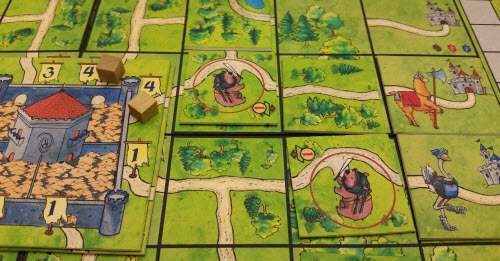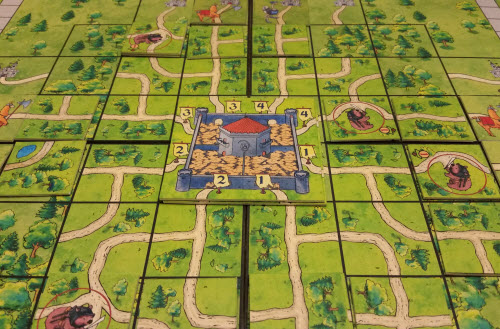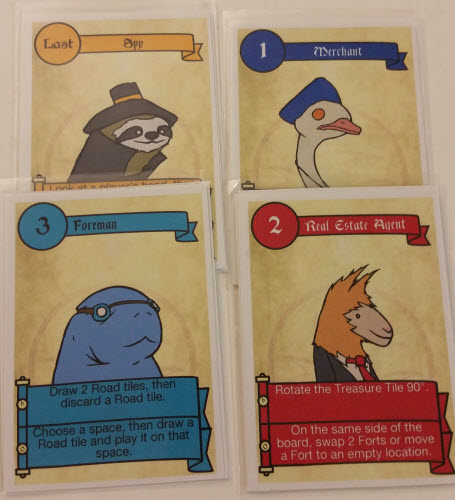We’ve said it before, and we’ll say it again: every good game needs more llama…

All the feels
Okay, fine, that sentence probably hasn’t been uttered, well, ever. But in this case, the llama clan is a welcomed component in The Kingswood, a tile-laying game of conflict and coinage.
In this 2-4 player game, the vast forest reaches known as The Kingswood are being sold off, which wouldn’t normally have caught the attention of its neighbors: the four great merchant houses of Sloth, Ostrich, Manatee, and yes, Llama. However, surveyors (whom we’re guessing are Gophers or something) have discovered a hefty gold deposit at the center, and that’s made everyone take notice. As a result, these houses have rushed into these woods to extract as much gold so they can to buy up the rest of The Kingswood first.
Yet while there may be honor among thieves, the same luxury is not granted to your fellow merchants, for the game’s simple appearance belies the underlying reality that most of what you do in The Kingswood is ensuring that your opponents’ caravans never make it out of the forest.
This is done by smoothly combining two beloved gaming mechanics: laying tiles, and using Action cards.
The initial Kingswood layout is a gridded, open landscape with a treasure tile – the location with all that golden goodness – in the center. Each treasure tile has eight randomized gate entrances, which players will use to get that much gold back to one of the four Forts they have along each of the board’s edges. Although the Forts have set locations based on the number of players, treasure tiles are randomly drawn at the beginning and halfway point of each game, giving an already random game even more replayability.
Your goal is to connect one of those treasured gates with your Forts, and therein lies the challenge of the tile laying. For, on each turn, you must place two tiles on any of the available spaces and then collect money from an unclaimed gate.
Yes, any tile.
Indeed, unlike many tile placement games, much of the fun in The Kingswood is overlaying one road tile heading straight to an opponent’s Fort with one that diverges off into the woods. Tiles don’t have to connect in any way, which makes sense: it’s in your best interest for the other caravans to get hopelessly lost while yours heads right for your front door. The only restriction to this placement is that some tiles have mercenary bears require a gold to allow tile placement on top of them. And it’s a bear with a sword, so just listen to him.
Afterwards, you reap the rewards of your strategic planning. Like everything else in this spirited game, collecting money is simple. First, you select an unclaimed gate and gain that much gold. Then you then get additional gold if your road runs through a tile with a faerie bunny (jus go with it) and / or if the road from the gate runs to your Fort(s) and no others. If you share the road with another Fort, no bonus for you. That gate is then closed for the round.

Red chose the 4 Value gate, getting an additional gold because it runs straight to Llama HQ.
Prototype Shown
Once each player places their tiles and collects their riches, players then go and get more gold. As savvy merchant houses, letting any amount of gold sit unclaimed each round is simply unacceptable. As such, after each player emptied one gate coffer, the rest of the gates are divvied out to the players along the same rules as before.
Beyond playing up the gold rush aspect, having a second round of collection helps players not get completely locked out of any gold on their turns due to poor planning, the machinations of their enemy houses (curse you Sloth!!), or their strategies going completely sideways. Not only does this keep players invested in the game, but it also lines up well thematically.
Which abilities you have each round – and when you get to take your turn – is determined by the game’s role cards. Similar to those found in games like Puerto Rico, each of the game’s five roles has a primary ability that you get to take on your turn, as well as a bonus ability you get if you are the only player to select that card. Although there’s only five, there is a surprising amount of strategy accompanying them, such as figuring out which one will benefit you the most at any given point, where in the turn order you wish to be, and to trying to guess which roles your opponents will choose. Each role can be highly advantageous depending on your current situation, from the Foreman’s ability to draw (and potentially place) an extra road tile to the Real Estate Agent’s prodigious power to rotate the treasure tile. These roles are both flavorful and their effects pair up seamlessly with the tile placement, offering players a respectable amount of strategic variety.
The appearance of the game is also worth noting, as there is a glaring juxtaposition between how it looks and how it plays. On its surface, The Kingswood could easily be mistaken for a more family-oriented expansion for Carcassonne, with copious road tiles and animal-based merchant guilds.
The turn structure is almost as simple too, as each player gets to take an action (or two), build a couple roads, and collect some precious gold. The Kingswood is remarkably easy to follow, making the game’s depth less about heavily weighted decisions or complex turns, and more about making the right moves in an ever-fluctuating landscape.
Once you get beyond the game’s outer brush, though, the facade is broken, and the similarities quickly disappear. It becomes quite apparent from the very first time one of your gold roads is diverted away from you that The Kingswood is far more fluid – and cutthroat – than it initially seems. In this game, players must simultaneously think ahead while trying to stifle the advancements of their rival houses. And this game heavily encourages that you do both.
That’s sort of where the animal aspect of The Kingswood comes in. On a purely abstract level, this is the type of confrontational game where you can and should do whatever is needed to win, whether that’s using your Merchant to go first for the best supply routes, or dropping down tiles to divert the best treasure gates away from your rivals. This is especially true with a full table, as the more players you have and the longer this relatively short game goes, the more it becomes impossible to do anything without antagonizing your opponents.

D’aww
But then you realize you just got outfoxed by a llama, and the ridiculousness of the situation sinks in.
Beyond helping the game stand out with its own unique flavor, it also keeps it from becoming too heated. Really, just try to stay mad at Manatee. We’re not sure it physically can be done.
The Kingswood proves to be a lightweight but conflict-driven game that requires players to think ahead. While the simple board design and artwork resemble a children’s storybook, the game has a surprising amount of strategic depth. Between a spatial reasoning challenge and a handful of rotating roles to choose from, The Kingswood is a deceptively clever game under the guise of a family-friendly expedition for riches, and to succeed, players have to keep a close eye on the constantly-changing map. Determining the best moves for your opponents and blocking them off before they can even begin is key, as is learning how to eek out even one extra point on your turn. With such tight scores, one mistake can be the difference between first place and last.
Do you think you can compete with House Llama for The Kingswood? If so, then be sure to head over to its Kickstarter. Don’t let someone steal it out from under you!
Photo Credits: Llama by Walt Disney Pictures; Manatees by Getty.


